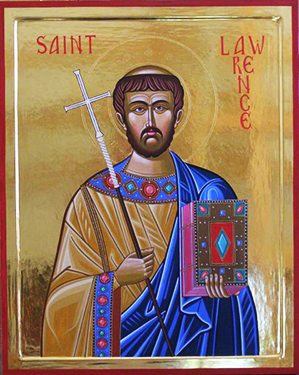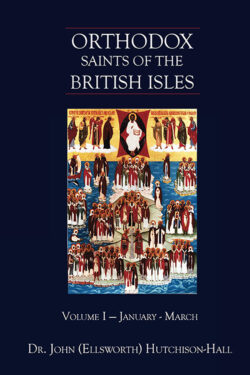
Orthodox Saints of the Pre-Schism
See of Rome
15th February (NS) — 2nd February (OS) 2024
ADALBALD, a Duke of Douai, and courtier in the courts of both King Dagobert I (r. 623–634) and King Clovis II (r. 639–657), St. Adalbald was a son of St. Gertrude the Elder (6th December). He and his wife St. Rictrudis (12th May) dedicated their time and wealth to various religious undertakings, as well as care of those in want. In addition, SS. Rictrudis and Adalbald raised four children, all of whom became saints: SS. Maurontius (9th January), Clotsindis (30th June), Eusebia (16th March), and Adalsindis (3rd May). Whilst traveling, St. Adalbald was murdered by an in-law acting on behalf of St. Rictrudis' family (circa 645–651), who had always disapproved of their marriage, and good works.
ADELOGA (HADELOGA), a daughter of Charles Martel, who renounced the world, and was the founding-Abbess of Kitzingen Abbey in Franconia (present-day Bavaria in Germany). St. Adeloga reposed circa 745.
APRONIAN, was a Roman executioner who, during the Diocletianic Persecution (circa 304), escorted St. Sininius (29th May) to the tribunal run by the Prefect Laudieius. St. Apronian was offered the chance to renounce Christ and thus be spared death. However, he made a statement of faith that was so passionate that St. Apronian converted on the spot, and was martyred shortly after St. Sininius.
COLUMBANUS, an Irishman and abbot who fled with his community fled the Viking raids, and settled in Ghent, Flanders. For the last two years of his life, St. Columbanus lived as a hermit near the church of Saint-Bavo in Ghent. St. Columbanus reposed in 959.
FEOCK, (Date Uncertain), aside from a church dedicated to her in Cornwall, her Life is unknown to us. It is possible she was an immigrant from Ireland, and there are some who believe that St. Feock is a variant of Fiacca, a Confessor, friend of St. Patrick (17th March), though this is unlikely. Lastly, there are those who identify St. Feock with St. Vouga (15th June) of Brittany.
FLOSCULUS (FLOU), (Fifth Century?) the thirteenth Bishop of Orléans. A letter from St. Sidonius Apollinaris (21st August) to St. Flosculus leads contemporary scholars to believe he was living circa 480. Nothing, save knowledge of the existence of a cultus, is known of his life.
LAURENCE of CANTERBURY, second Archbishop of Canterbury he was one of the forty monks sent by Pope St. Gregory the Dialogist (3rd September) with St. Augustine (27th May) to convert the Anglo-Saxons. According to St. Bede the Venerable (25th May), St. Augustine sent St. Laurence back to the Pope to report on the success of converting St. Æthelberht (24th February), King of Kent (r. 560–616), and to carry a letter with questions for the Pope. He returned with additional monks, as well as Pope St. Gregory the Dialogist’s (3rd September) replies to St. Augustine’s questions, a document commonly known as the Libellus responsionum, that St. Bede the Venerable (25th May) incorporated in his Historia ecclesiastica gentis Anglorum. St. Laurence was consecrated the second Archbishop of Canterbury in 604, by St. Augustine, in order to assure succession, and guided the young Church skilfully, and successfully, through the crisis that followed the death of King Æthelbert. St. Laurence reposed in 619, and was succeeded by St. Mellitus (24th April).
MARQUARD, a monk at New Corvey Abbey in present-day North Rhine-Westphalia, Germany. St. Marquard was consecrated Bishop of Hildesheim in 874, and served that See until his martyrdom, with others at Ebsdorf (vide infra) in 880.
MARTYRS of EBSDORF, In 880 members of the army of King Louis III, led by Duke St. Bruno of Ebsdorf, were trapped in the ice and snow at the Battle of Lüneburg Heath (Battle of Ebstorf) against pagan Norse invaders. All, including St. Bruno, St. Marquard of Hildesheim (vide supra) and St. Theodoric of Ninden (vide infra), a dozen members of the nobility, along with innumerable unnamed foot soldiers were slain and subsequently venerated as martyrs.
THEODORIC, a Bishop of Ninden counted amongst the Martyrs of Ebsdorf (vide supra) (†880).
Get your copy of Orthodox Saints of the British Isles today.
Available at Amazon or your favourite e-bookstore.
AGAPE (AGAPIA), a disciple of St. Valentine of Terni (14th February). St. Valentine placed her in charge of the community of women at he founded. St. Agape was martyred circa 273 at Terni in Umbria.
BERACH (BARACHIAS, BERACHIUS), (Sixth Century), a disciple of St. Kevin (3rd June), St. Berach founded a monastery at Clusin-Coirpte (now Termonbarry from the Irish: Tearmann Bearaigh, meaning “St. Barry’s sanctuary”) in Connaught. He is venerated in Co. Roscommon and is the patron saint of Kilbarry near Dublin.
CRATON and COMPANIONS, St. Craton was a Professor of Rhetoric and philosopher who was converted to Christianity by St. Valentine of Terni (14th February). St. Craton, his wife, children, and much of his household were martyred circa 273.
DECOROSUS, Bishop of Capua from 665 until his repose in 695. St. Decorossus was one of the prelates who, as a participant, signed the Acts of the Synod of Rome in 680, chaired by Pope St. Agatho (10th January).
DOCHOW (DOCHAU, DOGWYN), (Date Uncertain), there is a fair degree of uncertainty surrounding this saint. He is mentioned in the English Menology as a Welsh saint, though he may be the same as St. Cadoc (24th January), sometimes called St. Dockoe, or St. Dogmæl, St. Docmæl. There is a church in north-east Wales dedicated to a St. Docwy, or Dogway. It is probable that he was the founder of a monastery in Cornwall, and the Annals of Ulster describes him as a bishop.
DRUTHMAR, Abbot of the Imperial Abbey of Corvey in Saxony from 1014 until his repose in 1046.
FARANNAN, a native of Ireland St. Farannan went to Iona to become a disciple of St. Columba (9th June). He later settled in the West of Ireland, where he lived as an anchorite in a cave in the strictest asceticism, reposing circa 590. He is the patron saint of Alterna (All-Faranna) in Sligo, the probable place of his death.
FAUSTINUS and JOVITA, according to tradition, SS. Faustinus (a priest) and Jovita (a deacon) were brothers of noble birth who were energetic preachers of the Gospel throughout Lombardy. It is said they were martyred during the reign of Emperor Hadrian (r. 117–138). However, their well-established cultus notwithstanding, recent scholarship suggests their story is mere pious legend.
FAUSTUS, (Sixth Century), a disciple of St. Benedict (11th July) at Monte Cassino.
GEORGIA, an anchoress and wonderworker near the Abbey of our Lady of Clermont in Auvergne. St. Georgia reposed circa 500.
QUINIDIUS, after spending several years as a hermit in Aix in Provence, St. Quinidius was consecrated Bishop of Vaison. Several miracles are said to have resulted from his prayers. St. Quinidius reposed circa 579.
SATURNINUS, CASTULUS, MAGNUS, and LUCIUS, Christians from Passae in the Diocese of Terni, who like their Bishop, St. Valentine (14th February), were martyred 273.
SEVERUS, a sixth century priest in the Abruzzi. According to St. Gregory the Dialogist (3rd September), St. Severus' prayers raised a dead man to life, and healed many sick people.
SIGFRID (SIGFRIDAER), an English priest-monk, who went to Sweden, where he preached the Gospel to the locals, bringing many to Christ, including the King, Olaf. Towards the end of his life St. Sigfrid was consecrated Bishop of Växjö serving until is repose circa 1045.
WALFRID (GUALFREDO), the founding Abbot of Monte Virido in Tuscany. St. Walfrid reposed circa 765 and was succeeded as abbot by one of his sons.
WINAMAN, UNAMAN, and SUNAMAN, monks and fellow workers with their uncle St. Sigfrid (vide supra). They followed their uncle to Sweden, where they were martyred by pagans in the latter half of the eleventh century.
Prior to the Schism the Patriarchate of Rome was Orthodox, and fully in communion with the Orthodox Church. As Saint John of Shanghai and San Francisco +1966 said “The West was Orthodox for a thousand years, and her venerable Liturgy is far older than any of her heresies”.
Details of British Saints excerpted from Orthodox Saints of the British Isles.
Details of continental saints from these sources.
In many cases there are several spelling versions of the names of saints from the British Isles. I use the Oxford Dictionary of National Biography version as the primary version with the more prevalent version in parenthesis e.g. Ceadda (Chad) of Lichfield.


